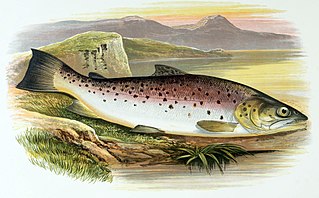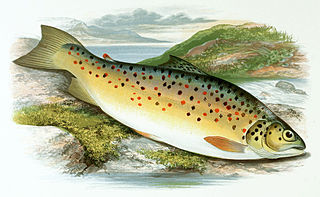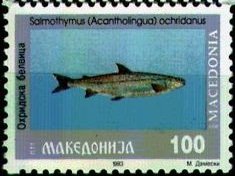
Salmo is a genus of ray-finned fish from the subfamily Salmoninae of family Salmonidae, and is part of the tribe Salmonini along with the sister genera Salvelinus and Salvethymus. Almost all Salmo species are native only in the Old World, the only exception being the Atlantic salmon, which is also naturally found across the North Atlantic in eastern North America.

Salmo trutta fario, sometimes called the river trout, is a river-dwelling freshwater predatory fish from the genus Salmo of the family Salmonidae. It is one of the three main subspecies of the brown trout, besides sea trout and the lacustrine trout.
Salmo obtusirostris salonitana is an endemic trout subspecies found in the Jadro River in the vicinity of Solin, and in the nearby Žrnovnica River, where it was introduced in 1964. The upper reaches of the Jadro River including Jadro Spring, covering an area of 7.8 hectares, have been protected as an ichthyological reserve since 1984, for the purpose of preserving this endangered fish species, S. o. salonitana.

Ferox trout is a variety of trout found in oligotrophic lakes/lochs of Ireland, England, Scotland and Wales. Ferox trout is a traditional name for large, piscivorous trout, which in Scotland feed largely on Arctic char. It has been argued to be a distinct species, being reproductively isolated from "normal" brown trout of the same lakes, particularly in Ireland. However, it is uncertain whether the ferox of different lakes are all of a single origin. This fish grows to a length of 80 centimetres (31 in) SL.

The Sevan trout is an endemic fish species of Lake Sevan in Armenia, known as ishkhan in Armenian. It is a salmonid fish related to the brown trout.

The gillaroo is a species of trout which eats primarily snails and is only proven to inhabit Lough Melvin in Ireland.

Salmo obtusirostris, commonly known as the softmouth trout, also known as the Adriatic trout, or Adriatic salmon, is a species of salmonid fish endemic to a handful rivers spilling into Adriatic in the Western Balkans, in southeastern Europe, namely in Bosnia and Herzegovina, Croatia and Montenegro. The scientific name has changed several times through history; synonyms include Thymallus microlepis, Salmothymus obtusirostris and Salar obtusirostris.

Ohrid trout or the Lake Ohrid brown trout is an endemic species of trout in Lake Ohrid and in its tributaries and outlet, the Black Drin river, in North Macedonia and Albania. Locally, the fish is known as охридска пастрмка in Macedonian and Koran or Korani in Albanian.

Salmo carpio, also known as the carpione, is a salmonid fish endemic to Lake Garda in Italy. It has been introduced to a number of other lakes in Italy and elsewhere but unsuccessfully in all cases. The population in Lake Garda has been strongly declining, and is considered critically endangered. The main threats are due to overfishing, pollution and possibly competition from introduced species such as Coregonus and other Salmonidae.
Barbus macedonicus is a species of cyprinid fish.

Salmo ohridanus, also known by the local name as the belvica in North Macedonia or belushka in Albania, is a species of freshwater salmonid fish, endemic to Lake Ohrid in Albania and North Macedonia.
Salmo balcanicus is a type of trout, a fish in the family Salmonidae. It is endemic to Lake Ohrid and its outlet in North Macedonia and Albania in the Balkans.

Salmo marmoratus, the marble trout, is a species of freshwater fish in the family Salmonidae. It is characterized by a distinctive marbled color pattern and high growth capacity. The marble trout is found in only a handful of drainages and rivers of the Adriatic basin in Italy, Slovenia, Croatia, Bosnia and Herzegovina, and Montenegro, while in Albania, the species is considered most likely extirpated.

Salmo peristericus, or the Prespa trout is a variety of trout, a freshwater fish in the family Salmonidae. It is endemic to the Lake Prespa watershed at the border area of Greece and North Macedonia.
Salmo platycephalus, known as the flathead trout, Ala balik or the Turkish trout, is a type of trout, a fish in the family Salmonidae. It is endemic to southeastern Turkey. It is known only from one population, which occupies three streams, tributaries of the Zamantı River in the Seyhan River basin. The population itself is abundant, but subject to threat by habitat loss, since the range is small. Also, predation of juveniles by introduced rainbow trout may cause population decline. The species is classified as critically endangered.

Salmothymus is a genus name of fish in the family Salmonidae, established for the Adriatic trout. More commonly, however, the species is considered a member of the wider genus Salmo, i.e. Salmo obtusirostris. Salmothymus thus is a junior synonym of Salmo, not in current use.

The Black Sea salmon is a fairly small species of salmon, at about 20 inches (510 mm) long on average and rarely reaching over 30 in (760 mm). It inhabits the northern Black Sea coasts and inflowing rivers. There are anadromous, lacustrine and resident river populations. This fish is a close relative of the brown trout. While it is the only native species of Salmo present in the northern Black Sea basin, it may hybridize with (introduced) brown trout in the major rivers. Sea-run populations are currently at low numbers, but the resident river stocks are doing well.
The fish fauna of the Neretva river basin in the western Balkans is representative of the Dinaric karst region and characterized by several endemic and endangered species.
Salmo rhodanensis, or the Rhône trout, is a salmonid fish, a putative species of trout resident in the Rhône river drainage in France and Switzerland. It was previously considered as belonging to Salmo trutta. Salmo rhodanensis is an exclusively freshwater fish, and is uniquely characterized by four broad black bars on its body: behind gill opening, under dorsal base, above anal fin origin, and at the base of the tail.














